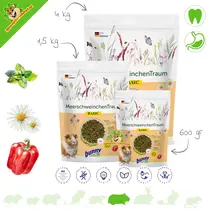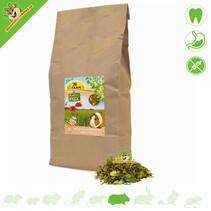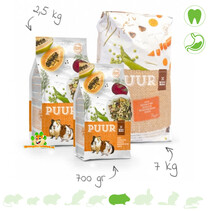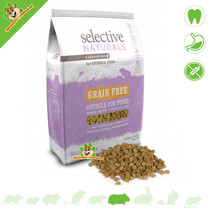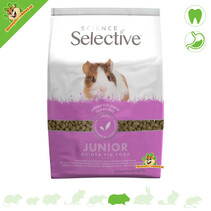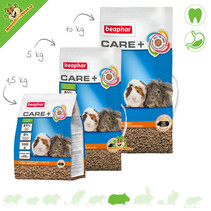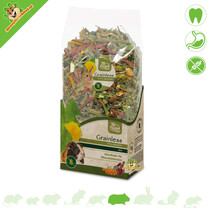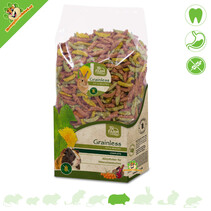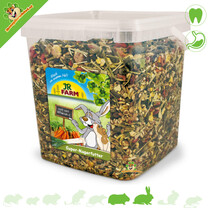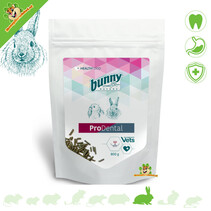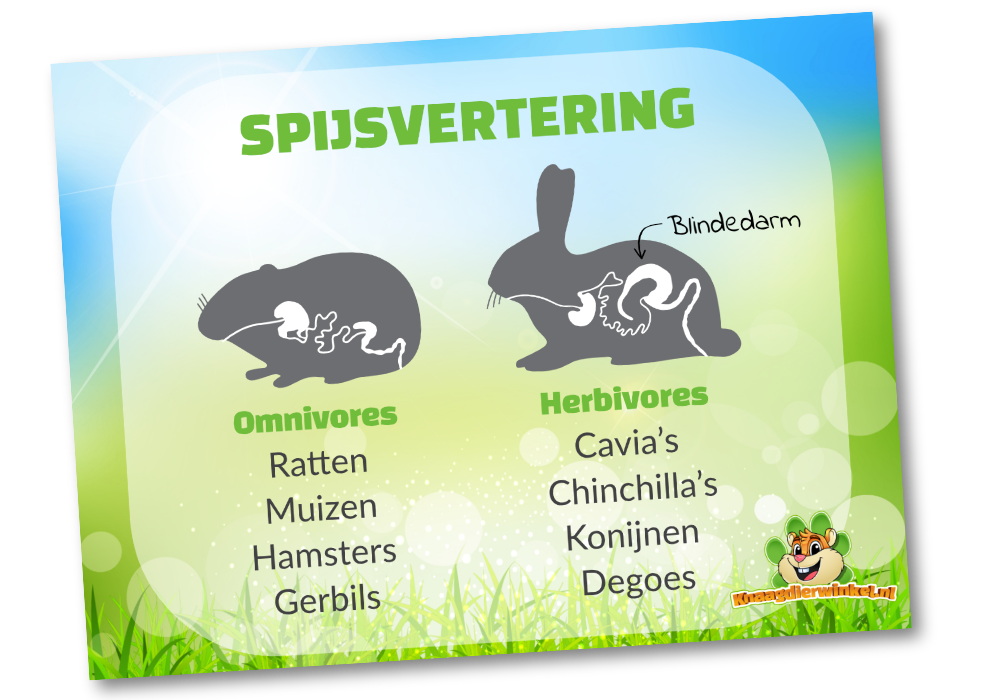Guinea Pig Food and Natural Guinea Pig Food | DRD Rodent Shop®
- Ordered before 5 p.m., shipped the same day!
- Al 14 jaar een begrip!
- Delivery from our own stock
- Ordered before 5 p.m., shipped the same day!
- Al 14 jaar een begrip!
- Delivery from our own stock
You can easily and quickly order guinea pig food for your beloved guinea pigs at DRD Rodent Shop ®
Welcome to DRD Rodent Shop, the guinea pig webshop for high-quality guinea pig food and natural guinea pig food. Discover our extensive range of healthy and balanced food for your beloved guinea pigs.
Guinea pig food for your guinea pig can always be ordered easily and quickly at DRD Rodent Shop! Do you want to spoil your guinea pig with healthy, balanced guinea pig food? You will find various types of guinea pig food at an attractive price. Ordering is easy and fast at DRD Rodent Shop!
What types of guinea pig food can you find here?
- All-in-one chunks & pellets – Prevents selective eating and ensures your guinea pig gets all essential nutrients.
Mixed diet – A varied diet with a mix of grains, vegetables and herbs for guinea pigs that like to forage.
Natural food – Pure and unprocessed, with fibre-rich ingredients such as grasses, flowers and herbs, without artificial additives.
Special food & force feeding – For guinea pigs with additional needs, such as veterinary food, diet food and force feeding during illness or recovery.
We understand the needs of your guinea pig like no other. That's why we offer a wide selection of healthy, balanced guinea pig food that will make your guinea pig salivate. What makes our range so special?
Why choose our guinea pig food?
-
Diversity: Our guinea pig food collection offers a wide variety of options including dry food, vegetables, fruits and more, so your guinea pigs can always enjoy a varied meal.
-
Easy Ordering: Order your guinea pig food quickly and easily at DRD Rodent Shop, so you can quickly spoil your furry friends.
-
Affordable Prices: We understand that quality must be affordable. That is why we offer attractive prices for the best guinea pig food.
Types of Guinea Pig Food
Guinea pig food comes in a variety of forms, including dry food, pellets, and muesli-like mixes. It is important to understand which type of food is best suited for your guinea pigs. In general, pellets are often recommended because they provide a balanced diet and prevent guinea pigs from selectively eating. Pellets contain all the essential nutrients that guinea pigs need, including vitamin C.
Vitamin C Supplementation and Guinea Pig Food
As mentioned earlier, guinea pigs need extra vitamin C in their diet because they cannot produce this vitamin themselves. A vitamin C deficiency can lead to serious health problems, including scurvy. In addition to vitamin C-rich vegetables and special tablets, you can make sure that the guinea pig food you choose contains sufficient vitamin C.
Guinea Pig Food and Dietary Diversity
Although pellets form the basis of the diet, it is important to offer guinea pigs a varied diet. This means that in addition to dry food, you should also offer fresh greens and fruit. Guinea pigs like variety and variation in their diet, which encourages them to eat enough.
Foraging Tip for Guinea Pigs!
 Do you want to treat your guinea pig to a healthy and fun activity? Then the Rodent Grocer Forage Menu for guinea pigs is an absolute must! This mix is specially composed to meet the natural needs of your guinea pig - from wearing down teeth to sniffing and discovering.
Do you want to treat your guinea pig to a healthy and fun activity? Then the Rodent Grocer Forage Menu for guinea pigs is an absolute must! This mix is specially composed to meet the natural needs of your guinea pig - from wearing down teeth to sniffing and discovering.
✔ Teeth in top shape: The fresh birch branches ensure that your guinea pig can wear down its teeth in a natural way. Good for the teeth and a nice nibbling activity!
✔ Against boredom: Thanks to the varied textures and scents - from soft leaves to sturdy stems - your guinea pig will remain captivated and active for hours. Ideal to prevent boredom.
✔ Nutritious and varied treat: With ingredients such as alfalfa, clover, fennel stalks, lavender and mint, you give your guinea pig a new taste adventure every day. These natural plants are packed with healthy nutrients.
✔ Natural treats: The addition of dried apple pieces gives a crunchy surprise that guinea pigs love – completely unsweetened and therefore responsible!
Hay and Roughage in addition to Guinea Pig Food
Hay is an essential part of a guinea pig's diet. It not only provides fiber, which is essential for healthy digestion, but also helps wear down their teeth. Guinea pigs should have access to fresh hay at all times. Make sure the hay is clean and dust-free to prevent respiratory problems.
Fresh Green Food and Fruit
Guinea pigs enjoy a variety of fruits and vegetables. These include leafy greens such as endive, iceberg lettuce, spinach and parsley, as well as bell peppers, carrots, tomatoes and other vegetables high in vitamin C. Fruits such as apples, pears and oranges can be given in moderation due to their fruit sugars.
Be careful with types of cabbage
It is important to note that cabbages, such as kale and broccoli, are not suitable for guinea pigs. These vegetables can cause gas and digestive problems. Older and weaker guinea pigs are particularly susceptible to these effects.
Water
In addition to solid food, fresh water is essential for guinea pig health. Make sure they always have access to clean drinking water. Guinea pigs' drinking behavior can vary depending on their diet, so it is important to regularly check and refill their water bottle.
Nutritional balance
Maintaining a balanced diet for guinea pigs is crucial to prevent overweight or deficiencies. Being overweight can lead to health problems such as heart disease, while deficiencies can lead to other health problems. It is advisable to consult with a veterinarian about the right diet for your guinea pig, especially if they have specific health problems.
Why do guinea pigs prefer to eat all day long?
Guinea pigs actually prefer to eat all day long, so it is good for the animals to spread the feeding over the entire day. For example, dry food twice a day and vegetables and fruit at other times.
Guinea pigs are true gourmets and nibblers. They enjoy eating all day long, and there is a special reason for this behavior. By dividing the daily diet into several meals, such as dry food twice a day and vegetables and fruit at other times, guinea pigs can satisfy their natural tendency to nibble constantly.
Why are guinea pigs herbivores?
Guinea pigs are small, folivorous/herbivorous (plant-eating) mammals and belong to the order of rodents. They mainly eat grass, vegetables, herbs, flowers, plants, roots and twigs. The diet of the guinea pig should therefore contain these ingredients daily.
Did you know?
Guinea pigs drink an average of between 100 and 400 ml of water?
There are therefore quite large differences in drinking behaviour between guinea pigs. Drinking behaviour is mainly influenced by food. A guinea pig that has eaten a lot of hay and/or dry food will drink more and a guinea pig that has had more green food will drink less.
For a relatively small animal like the guinea pig, the digestive tract is large. Like all herbivores, the guinea pig is also equipped with a larger appendix. The appendix of the guinea pig takes up to 50-75% of the abdominal cavity.
The food is first thoroughly pre-chewed in the mouth. Once in the stomach, the food is mixed with gastric juices. Proteins, fats and some of the carbohydrates/sugars are absorbed. The rest of the food goes to the appendix and undergoes the fermentation process there.
What is coprophagy in guinea pigs?
Guinea pigs produce two different droppings, just like rabbits. In rabbits, both droppings are different, one is hard and dry and the other soft and moist (night droppings). In guinea pigs, there is almost no difference. The night droppings are eaten by the guinea pig, which we call "Coprophagy". Rabbits also do this once or twice a day, but guinea pigs take the crown with about a hundred to a hundred and fifty times a day!
Did you know?
The Guinea pig has an even longer intestinal tract than the rabbit? The reason for this is that rabbits often get more easily digestible food and eat much more selectively. This means that the bacteria in the rabbit's stomach don't have to work as hard.
Guinea pigs generally eat less selectively and also lower energy foods than rabbits.
How do Guinea Pigs eat in the wild?
Because guinea pigs in the wild eat roughage all day long, such as grasses and plants with a relatively low energy value, they really have to eat all day long. Not only for their energy needs, but also for their teeth that always continue to grow. By chewing, the incisors wear down and remain at a good length. Roughage in the form of hay is therefore indispensable for a guinea pig and must be available to the animals all day long.
Tip! Some new Guinea pigs can be a bit scared at first. Therefore, do not hang the hay rack too far from the house. If the rack is a bit closer to the house, even the shy animals will eat hay more easily. It can also be useful to place a toilet under the hay rack, so that the droppings are immediately collected.
What to do if the guinea pig eats selectively?
For selective eating animals we always recommend an all in one chunk, so that the animals cannot choose the tasty components from the food and thus get everything they need. There are different types of guinea pig food, each with its own advantages and disadvantages. It is very important for a guinea pig that the food contains sufficient vitamin C, because the guinea pig cannot produce this itself.
Are Fruits and Vegetables Suitable for Guinea Pigs?
It is good to give the guinea pig different types of raw (leaf) vegetables, herbs and a small amount of fruit daily. Vegetables with a high percentage of vitamin C are preferred. Vegetables and fruit should always be rinsed well and offered at room temperature. Do not give them from the refrigerator, that is too cold and can upset the intestines. Do not give the guinea pig cabbages, the intestines can also not handle them as well, especially older and weak animals have difficulty with this. Limit fruit to a small piece per day because of the fruit sugars.
Good to know!
If a guinea pig is not yet used to green food, it is useful to first get him used to it by introducing small amounts to the daily menu.
Why should guinea pigs get extra vitamin C?
Guinea pigs do not produce vitamin C themselves, this vitamin must therefore be added to their daily diet. Vitamin C is added to guinea pig food as standard, but in some cases it may be necessary to provide extra vitamin C, this can be done by giving them vitamin C-rich vegetables or special tablets. Vitamin C is broken down by illness and stress. Animals that have been ill or under stress must be given extra vitamin C.
What does a guinea pig's digestion look like?
There are two incisors in each of the upper and lower jaws of the Guinea Pig, which, like the molars, continue to grow throughout life. This means:
a) the position of the teeth must be correct so that tooth wear is possible and the teeth do not grow uncontrollably.
b) the choice of feed is an important factor for the optimal wear of the incisors and molars. A high fibre content is necessary!
The Guinea Pig Stomach
The guinea pig's stomach is a so-called stuffed stomach. The stomach is very moderately muscular and therefore cannot independently transport the food pulp to the next part of the intestine. The following food portions take over that task. This actually means that only by eating can the food pass through the digestive tract because each new portion of food pushes the old one along. A great danger therefore also lies in not eating. As soon as the animals do not eat for a while, the complete digestion also comes to a standstill. This can be very dangerous.
The appendix of a guinea pig
The large appendix is the so-called fermentation chamber. The fine dietary fibres go there, which are converted into proteins, vitamin B complex and vitamin K by special bacteria. This is where the appendix pellets are formed, which are reabsorbed by guinea pigs.
What are the calcium requirements of the guinea pig?
Calcium is an important mineral. In the body, calcium is mainly found in the bones and teeth. The calcium supply through food is therefore very important to keep the animal healthy.
It is true that an increased calcium level in adult guinea pigs can lead to bladder grit or even bladder stones. Unfortunately, this is no longer a rarity. That is why the choice of the right components is important.
Optimal calcium content in the basic feed:
young animals: 0.9%*
adult animals : 0.6%
*Young animals require a higher calcium content due to their growth compared to adult guinea pigs.
Why are crude fibers important for guinea pigs?
Crude fibers: Crude fibers are very important for health. They support digestion, the appendix and with their rough fiber structure, tooth wear.
Starch: Starch is mainly an energy supplier and should be present in limited quantities in the feed.
A shift in the crude fiber-starch ratio can lead to long-term health damage:
Too little crude fibre leads to intestinal sluggishness, changes in intestinal flora and disturbed functioning of the appendix.
Too much starch leads to eating pauses, changes in intestinal flora, swelling, diarrhea, fermentation, obesity.
A crude fibre content of 3:1 is recommended for the Guinea Pig.
How do I actually know how much starch my food contains?
The composition is very useful: whole grains (with starchy endosperm), field beans, potatoes or peas are an indication that a higher starch content should be taken into account.
These plants can be eaten by guinea pigs
Wild Plants |
Branches and Leaves |
Vegetables |
|---|---|---|
| Strawberry leaf Bindweed Amaranth Mugwort Buckwheat Chives Nettle (dried) Goldenrod Canadian fine-ray Wild garlic Dead Nettle Yarrow Speedwell Angelica Cow parsley Great Wall Plantain Cat's tail Large poppy Common agrimony Marigold Common pigweed Regular rocket Common Hogweed Hedge bindweed Horsetail Herik pigeonhole Ground Ivy Shepherd's purse Hop Hawkweed Horn flower deer hay Hedge vetch Incarnate clover Japanese knotweed Mallow/Malva Chamomile Cleavers Nodding avens Knotweed Knotweed Borage Compass lettuce Queen Anne's Lace Rapeseed Cornflower blue Cornflower Red Coltsfoot Clover Wood sorrel Burdock Look-without-look Sweet pea violet Daisy Marguerite Report Milk Thistle/Lady Thistle Avens stork's bill Dandelion Bee bread Arrowhead Cress Pennywort Pimpernel Bird's-foot trefoil Comfrey Coleus Runner seed Narrow-leaved plantain Evening primrose Torch Valerian Lamb's lettuce Field cress Cinquefoil Vetch Chickweed Toadflax Lady's mantle Bedstraw Chicory Wild carrot Winter purslane White Krodde White watercress Black Green Ground elder Silverweed Sunflower Coneflower/Echinacea Sorrel |
Currant bush |
Endive Celery Broccoli Zucchini Iceberg lettuce Cucumber Lettuce Bell pepper Parsnip Parsley root Pumpkin Purslane |






